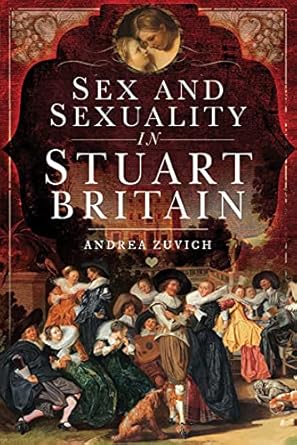In the course of the research for My Queen, My Love, I found the work of "Seventeenth Century Lady" Andrea Zuvich immensely helpful. Her recent book Sex and Sexuality in Stuart Britain (Pen and Sword) is indispensable for anyone engaged in a study of England in the 1600's. However, if you are searching for a purely lascivious read, this book might not be for you. Andrea's careful anthropological and sociological scholarship is expressed with grace and precision, and with a high regard for human dignity, while withholding judgment. She presents the facts but in an easy, often humorous, conversational manner, which gives the reader a sense of the era. Like a true historian, Andrea lets us make up our own mind about certain controversial persons and situations, while offering opinions based upon evidence, where it exists. While not purporting to be a full assessment of the private lives of the various monarchs and assorted courtiers, the book assists contemporary students of history to understand the often shadowy relationships between people who had affection for each other. A major take-away of the work is that just because two people wrote to each other in flowery, sensual language does not mean they had a physical relationship. The English language, which had just blossomed in the Elizabethan era, was incredibly lavish and effervescent throughout the 1600's. While Puritanism had taken hold, the peoples of Stuart Britain were not Victorians; mentioning the functions of the body was not as taboo as it later became. The language used in Shakespeare, which is often salty, as well as the majestic prose of the King James Bible, were how many people expressed themselves in both private and public.
It was a bawdy age, nevertheless, especially in the period known as the Restoration, when King Charles II returned from exile to reign after the austere Cromwellian Interregnum. King Charles and his flamboyant mistresses set the tone for the second half of the century. Andrea includes quotes in the book as the only way to really grasp how coarse some folk could be. (Certain passages are not recommended for nuns, virgins or sensitive, sheltered souls.) Yet there were throughout society virtuous persons, especially the Stuart Queens, who appeared to have had a subtle influence on the culture, keeping it from becoming completely hedonistic. Indeed, most women were still expected to be virgins when they married for the first time. All the Queen Consorts were devout Catholics. Later, the Protestant Queens, Mary and Anne, did a great deal to reform morals and manners. And children, the fruits of sexuality, were welcomed, legitimate or not, since so many died in infancy. Primitive means of contraception existed, as did abortion, although the paramours of Charles II and James II did not appear to use such methods, as the Stuart bastards were plentiful, and their descendants are with us today.
My favorite parts of the book are the great love stories of the Stuart Kings and Queens, of which sexuality played a huge part while not being an end in itself. Charles I and Henrietta Maria shared a passionate marriage but their love for each other endured long after they had been separated by the years and miles during Charles' imprisonment. Charles II and James II both came to love and respect their faithful Catholic Queens. William III and Mary II were gradually more and more devoted to each other; Queen Anne and her husband George of Denmark cherished each other through many tragedies, including the loss of all seventeen of their children. Sex ends; love endures forever.
Visit Andrea at her Seventeenth Century Lady blog, HERE.


















No comments:
Post a Comment